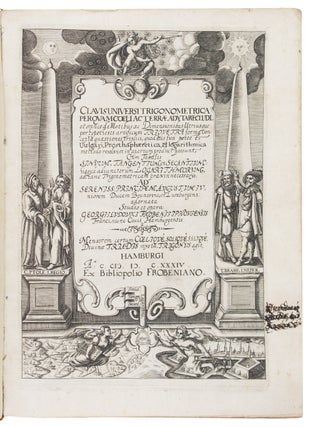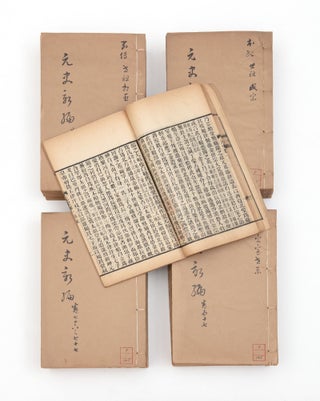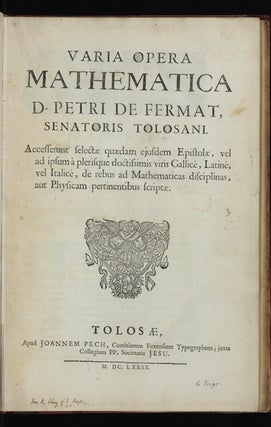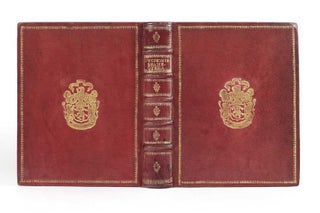The Typography Explains the Text;
A Masterpiece of Movable Type
Chokusen meisho waka shoshutsu 勅撰名所和歌抄出 [Imperially Chosen Collection of Famous Place Names Codified for Waka Poetry].
Ten columns per page with interlinear printing in a smaller font. Text-block: 233 x 160 mm. 85; 88 folding leaves. Two vols. Large 8vo (280 x 198 mm.), orig. persimmon-stained wrappers, orig. block-printed title labels on upper covers, new stitching. [Kyoto?]: mid-Genna [before 1617?].
First edition, extremely rare, with no copy in WorldCat, of this masterpiece of movable wood type printing, exhibiting both kanji, in three font sizes and several styles, and hiragana, in one elegant font. All these beautiful fonts employ extensive use of ligatures, enabling the print to represent the flow of calligraphy, much in the style of the famous Sagabon. The quantity of wooden type used to print this work must have been enormous.
The hiragana and kanji wood types are extremely calligraphic and fluid, a notable departure from earlier Japanese movable type books, which had been laid-out very much in the tighter tradition of the Chinese style. The appearance of our book clearly resembles the earlier manuscripts of the text. The layout is complex, with each font performing a separate function. The 60 chapter headings — “tall mountains,” “valleys,” “mountain ranges,” “hot springs,” “bridge,” “ocean,” “peninsula,” “harbor,” “forest,” “palace,” “shrines,” etc. — are printed in one size of kanji font, then the alphabetical order of the Japanese syllables appears in very small hiragana, and the place names and regions are in the same font as the chapter headings. The descriptions of places and poetical references are set in two tight short lines in a small kanji typeface. The actual sample poems are printed in a mixture of kanji and hiragana with many ligatures to imitate calligraphic hands.
This collection of place names, arranged in Japanese syllabic order instead of geographically classified, was compiled in 1506 by Soseki (1474-1533), a Kyoto priest and renowned renga poet. He had studied with Sogi (1421-1502), the greatest renga master of the 15th and early 16th centuries. Soseki was assisted in the compilation of this book by Sanetaka Sanjonishi (1455-1537), also a disciple of Sogi. The poems were selected from Man’yoshu, the oldest extant collection of Japanese poetry and the most highly revered today, and the 21 Chokusenshu, anthologies of waka poetry compiled over 534 years by imperial command.
Soseki’s arrangement of place names was completely different from its predecessor, the Chokusen meisho waka yosho, compiled in the late 14th century, which has apparently remained in manuscript only. Soseki’s text made consultation much easier.
The text of this book remained in manuscript until it was finally printed here in about 1617 or slightly before. In 1617 a later collection of place names was printed using movable type, Ruiji meisho waka shu by Shotaku Satomura (1574-1636), a descendant of Joha Satomura. It used a similar layout and selection of fonts.
PROVENANCE: Our copy appeared in the 40th-anniversary catalogue (No. 42) of the great Japanese bookseller Shigeo Sorimachi. This important catalogue, published in 1972, was devoted to movable type books, and our book was item 249 (pp. 326-27). At that time, Sorimachi located only two other copies; we have located two more. All are in Japan.
A fine set. Minor soiling and unimportant worming, carefully repaired. Preserved in a new wooden box.
❧ Kazuma Kawase, Kokatsuji-ban no kenkyu [Study of the Early Typographic Editions of Japan] (1967), I, p. 55 & III, p. 152, no. 462 for a reproduction. Kawase describes this book as (in trans.): “fresh type…pristinely printed.”.
Price: $47,500.00
Item ID: 8180

![Item ID: 8180 Chokusen meisho waka shoshutsu 勅撰名所和歌抄出 [Imperially Chosen Collection of Famous Place Names Codified for Waka Poetry]. SOSEKI, Pen-name: Gessonsai SOSEKI.](https://jonathanahill.cdn.bibliopolis.com/pictures/8180.jpg?width=768&height=1000&fit=bounds&auto=webp&v=1649702765)
![Chokusen meisho waka shoshutsu 勅撰名所和歌抄出 [Imperially Chosen Collection of Famous Place Names Codified for Waka Poetry].](https://jonathanahill.cdn.bibliopolis.com/pictures/8180_2.jpg?width=320&height=427&fit=bounds&auto=webp&v=1649702765)
![Chokusen meisho waka shoshutsu 勅撰名所和歌抄出 [Imperially Chosen Collection of Famous Place Names Codified for Waka Poetry].](https://jonathanahill.cdn.bibliopolis.com/pictures/8180_3.jpg?width=320&height=427&fit=bounds&auto=webp&v=1649702765)
![Chokusen meisho waka shoshutsu 勅撰名所和歌抄出 [Imperially Chosen Collection of Famous Place Names Codified for Waka Poetry].](https://jonathanahill.cdn.bibliopolis.com/pictures/8180_4.jpg?width=320&height=427&fit=bounds&auto=webp&v=1649702765)
![Chokusen meisho waka shoshutsu 勅撰名所和歌抄出 [Imperially Chosen Collection of Famous Place Names Codified for Waka Poetry].](https://jonathanahill.cdn.bibliopolis.com/pictures/8180_5.jpg?width=320&height=427&fit=bounds&auto=webp&v=1649702765)



